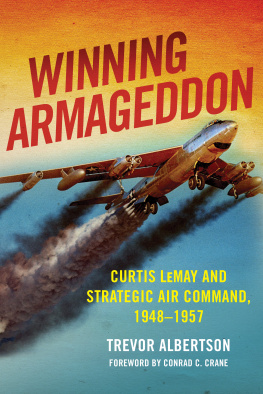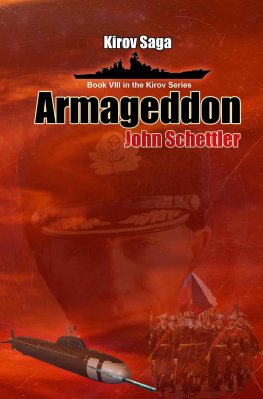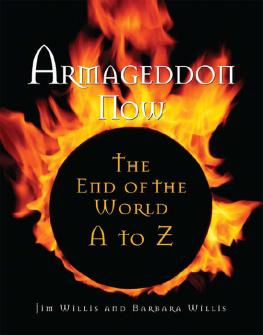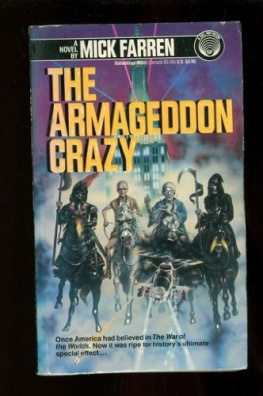Trevor Albertson - Winning Armageddon
Here you can read online Trevor Albertson - Winning Armageddon full text of the book (entire story) in english for free. Download pdf and epub, get meaning, cover and reviews about this ebook. year: 2019, genre: Politics. Description of the work, (preface) as well as reviews are available. Best literature library LitArk.com created for fans of good reading and offers a wide selection of genres:
Romance novel
Science fiction
Adventure
Detective
Science
History
Home and family
Prose
Art
Politics
Computer
Non-fiction
Religion
Business
Children
Humor
Choose a favorite category and find really read worthwhile books. Enjoy immersion in the world of imagination, feel the emotions of the characters or learn something new for yourself, make an fascinating discovery.
- Book:Winning Armageddon
- Author:
- Genre:
- Year:2019
- Rating:3 / 5
- Favourites:Add to favourites
- Your mark:
- 60
- 1
- 2
- 3
- 4
- 5
Winning Armageddon: summary, description and annotation
We offer to read an annotation, description, summary or preface (depends on what the author of the book "Winning Armageddon" wrote himself). If you haven't found the necessary information about the book — write in the comments, we will try to find it.
Winning Armageddon — read online for free the complete book (whole text) full work
Below is the text of the book, divided by pages. System saving the place of the last page read, allows you to conveniently read the book "Winning Armageddon" online for free, without having to search again every time where you left off. Put a bookmark, and you can go to the page where you finished reading at any time.
Font size:
Interval:
Bookmark:

WINNING ARMAGEDDON
Titles in the Series

Airpower Reborn: The Strategic Concepts of John
Warden and John Boyd
The Bridge to Airpower: Logistics Support for Royal
Flying Corps Operations on the Western Front, 191418
Airpower Applied: U.S., NATO, and Israeli Combat Experience
The Origins of American Strategic Bombing Theory
Beyond the Beach: The Allied Air War against France
The Man Who Took the Rap: Sir Robert Brooke-Popham
and the Fall of Singapore
Flight Risk: The Coalitions Air Advisory Mission
in Afghanistan, 20052015
The History of Military Aviation
Paul J. Springer, editor

This series is designed to explore previously ignored facets of the history of airpower. It includes a wide variety of disciplinary approaches, scholarly perspectives, and argumentative styles. Its fundamental goal is to analyze the past, present, and potential future utility of airpower and to enhance our understanding of the changing roles played by aerial assets in the formulation and execution of national military strategies. It encompasses the incredibly diverse roles played by airpower, which include but are not limited to efforts to achieve air superiority; strategic attack; intelligence, surveillance, and reconnaissance missions; airlift operations; close-air support; and more. Of course, airpower does not exist in a vacuum. There are myriad terrestrial support operations required to make airpower functional, and examinations of these missions is also a goal of this series.
In less than a century, airpower developed from flights measured in minutes to the ability to circumnavigate the globe without landing. Airpower has become the military tool of choice for rapid responses to enemy activity, the primary deterrent to aggression by peer competitors, and a key enabler to military missions on the land and sea. This series provides an opportunity to examine many of the key issues associated with its usage in the past and present, and to influence its development for the future.
WINNING ARMAGEDDON
CURTIS LEMAY AND
STRATEGIC AIR COMMAND,
19481957
TREVOR ALBERTSON
Naval Institute Press
Annapolis, Maryland
Naval Institute Press
291 Wood Road
Annapolis, MD 21402
2019 by Trevor Albertson
All rights reserved. No part of this book may be reproduced or utilized in any form or by any means, electronic or mechanical, including photocopying and recording, or by any information storage and retrieval system, without permission in writing from the publisher.
Library of Congress Cataloging-in-Publication Data
Names: Albertson, Trevor, date, author.
Title: Winning armageddon : Curtis LeMay and Strategic Air Command, 19481957 / Trevor Albertson.
Description: Annapolis, Maryland : Naval Institute Press, [2019] | Series: The history of military aviation | Includes bibliographical references and index.
Identifiers: LCCN 2018060112 (print) | LCCN 2019001252 (ebook) | ISBN 9781682474471 (epdf) | ISBN 9781682474228 (hardcover : alk. paper)
Subjects: LCSH: LeMay, Curtis E. | First strike (Nuclear strategy) | United StatesMilitary policy. | Nuclear warfareUnited StatesHistory20th century. | United States. Air Force. Strategic Air CommandHistory.
Classification: LCC UA923 (ebook) | LCC UA923 .A43 2019 (print) | DDC 355.02/17097309045dc23
LC record available at https://lccn.loc.gov/2018060112
 Print editions meet the requirements of ANSI/NISO Z39.48-1992 (Permanence of Paper).
Print editions meet the requirements of ANSI/NISO Z39.48-1992 (Permanence of Paper).
Printed in the United States of America.
27 26 25 24 23 22 21 20 199 8 7 6 5 4 3 2 1
First printing
 For Belle, Buddy, and Tallulah; thanks, Beags.
For Belle, Buddy, and Tallulah; thanks, Beags. 
Contents

by Conrad C. Crane
Foreword

M y favorite elective to teach when I was a professor of history at West Point was entitled Generalship and the Art of Command. The course examined great captains such as Alexander and Napoleon but also focused on commanders classified as transformational leaders who turned losers into winners in tough circumstances. Examples included Philippe Petain, who rejuvenated the French army after the mutinies of 1917, and Matthew Ridgway, who restored the fighting spirit of the U.S. Eighth Army in Korea in early 1951 after the longest retreat in U.S. military history. The course also included an examination of selected naval and air leaders, including Curtis LeMay. No U.S. general better fits the definition of transformational leader. LeMay inspired outstanding performance in the units he commanded in the Eighth Air Force and the Twentieth Air Force during World War II and in the postwar Strategic Air Command. His unique operational expertise and leadership skills were well recognized by his superiors, who consistently gave him the hardest jobs in the most critical places. He was the most renowned problem solver in the Army Air Forces/U.S. Air Force. As Brig. Gen. Lauris Norstad, Twentieth Air Force chief of staff, remarked when LeMay was given command of all bombing operations against Japan out of the Mariana Islands in early 1945, LeMay is an operator, the rest of us are planners.
One of LeMays greatest attributes was his ingenuity. No airman in history has been more innovative. He did not just think outside of the box; to him, there was no box. He envisioned no restrictions beyond those imposed by technological limitations. During World War II in Europe, he came up with the optimal design of staggered bomber formations to increase defensive firepower, implemented the nonevasive action bomb run to improve targeting accuracy, and initiated the training of selected lead crews to specialize on each objective. He pioneered the use of after-action reviews and systems analysis. In the Pacific, he resorted to low-level night fire-bombing of Japanese cities that decimated industry there while killing hundreds of thousands of civiliansone of the key blows that prompted Japans surrender. After that devastating war, he became the main architect of the Berlin airlift, shifting easily from dumping incendiaries on Japanese children to dropping candy to German ones, and executing many extralegal actions to circumvent peacetime rules of European allies. And he transformed the postwar Strategic Air Command into the most competent and deadliest military force on the planet.
It is not surprising then, as Trevor Albertson so thoroughly reveals, that LeMay intensely analyzed the problem of winning the nuclear war he would have to fight. And again his solution was unique, shaped by his evaluation of the capabilities of the weapons at his disposal. His plan for a preemptive war was a counterforce strategy that would take away most of the enemys capability to fight back, leaving them with the decision of whether to expand the war into the countervalue realm of indiscriminately destroying cities. While often inaccurately compared to the character of Gen. Jack D. Ripper in the movie
Next pageFont size:
Interval:
Bookmark:
Similar books «Winning Armageddon»
Look at similar books to Winning Armageddon. We have selected literature similar in name and meaning in the hope of providing readers with more options to find new, interesting, not yet read works.
Discussion, reviews of the book Winning Armageddon and just readers' own opinions. Leave your comments, write what you think about the work, its meaning or the main characters. Specify what exactly you liked and what you didn't like, and why you think so.












